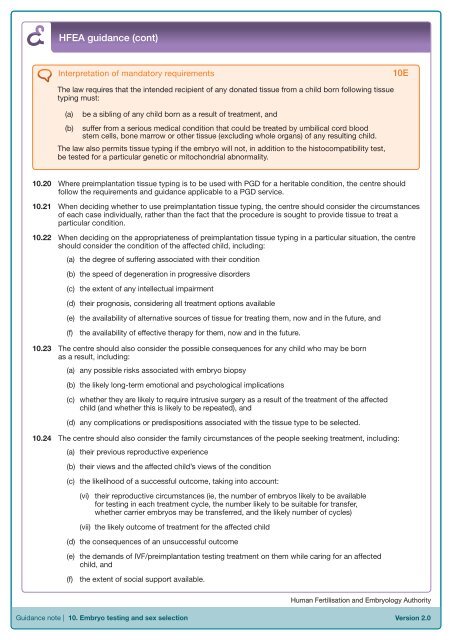Eighth Edition - R.3 - Human Fertilisation & Embryology Authority
Eighth Edition - R.3 - Human Fertilisation & Embryology Authority
Eighth Edition - R.3 - Human Fertilisation & Embryology Authority
You also want an ePaper? Increase the reach of your titles
YUMPU automatically turns print PDFs into web optimized ePapers that Google loves.
HFEA guidance (cont)<br />
Interpretation of mandatory requirements<br />
10E<br />
The law requires that the intended recipient of any donated tissue from a child born following tissue<br />
typing must:<br />
(a)<br />
be a sibling of any child born as a result of treatment, and<br />
(b) suffer from a serious medical condition that could be treated by umbilical cord blood<br />
stem cells, bone marrow or other tissue (excluding whole organs) of any resulting child.<br />
The law also permits tissue typing if the embryo will not, in addition to the histocompatibility test,<br />
be tested for a particular genetic or mitochondrial abnormality.<br />
10.20 Where preimplantation tissue typing is to be used with PGD for a heritable condition, the centre should<br />
follow the requirements and guidance applicable to a PGD service.<br />
10.21 When deciding whether to use preimplantation tissue typing, the centre should consider the circumstances<br />
of each case individually, rather than the fact that the procedure is sought to provide tissue to treat a<br />
particular condition.<br />
10.22 When deciding on the appropriateness of preimplantation tissue typing in a particular situation, the centre<br />
should consider the condition of the affected child, including:<br />
(a)<br />
(b)<br />
(c)<br />
(d)<br />
(e)<br />
(f)<br />
the degree of suffering associated with their condition<br />
the speed of degeneration in progressive disorders<br />
the extent of any intellectual impairment<br />
their prognosis, considering all treatment options available<br />
the availability of alternative sources of tissue for treating them, now and in the future, and<br />
the availability of effective therapy for them, now and in the future.<br />
10.23 The centre should also consider the possible consequences for any child who may be born<br />
as a result, including:<br />
(a)<br />
(b)<br />
any possible risks associated with embryo biopsy<br />
the likely long-term emotional and psychological implications<br />
(c) whether they are likely to require intrusive surgery as a result of the treatment of the affected<br />
child (and whether this is likely to be repeated), and<br />
(d)<br />
any complications or predispositions associated with the tissue type to be selected.<br />
10.24 The centre should also consider the family circumstances of the people seeking treatment, including:<br />
(a) their previous reproductive experience<br />
(b)<br />
(c)<br />
(d)<br />
their views and the affected child’s views of the condition<br />
the likelihood of a successful outcome, taking into account:<br />
(vi) their reproductive circumstances (ie, the number of embryos likely to be available<br />
for testing in each treatment cycle, the number likely to be suitable for transfer,<br />
whether carrier embryos may be transferred, and the likely number of cycles)<br />
(vii)<br />
the likely outcome of treatment for the affected child<br />
the consequences of an unsuccessful outcome<br />
(e) the demands of IVF/preimplantation testing treatment on them while caring for an affected<br />
child, and<br />
(f)<br />
the extent of social support available.<br />
<strong>Human</strong> <strong>Fertilisation</strong> and <strong>Embryology</strong> <strong>Authority</strong><br />
Guidance note | 10. Embryo testing and sex selection<br />
Version 2.0<br />
1.0

















